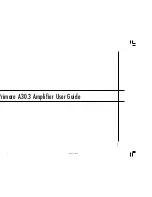
FOREWORD
4
Microphones as Ears
by Bruce Botnick
I've always felt that microphones were colors on a sound painter's palette. Colors that can be used to bring out
the many sounds that we record and help us to create different textures used in the mix.
Many recording engineers have their favorite microphones and don't necessarily use the same favorite on the
same instrument in all applications. In creating the sound field, the mixer will look at the instrumentation, the
microphones available, and make his choice based upon what he knows will work and what he hears in his
imagination.
Equating Imagination when it comes to recording music is like comparing the improvisational work of a fine
musician. You have to know your tools by heart in order to be free enough to dream in full three dimensional
stereo and color.
Back in the early days of hi-fi, monaural long playing records, when I was really, really young; I can remember
hearing people breathing on recordings. Hearing the rosin of the bow on the strings of a violin. The fingernails
of a pianist on the ivories. I could never hear that on old 78's as a majority of the microphones used up till the
1950's were ribbons. Radio Recorders had basically only ribbons, RCA 44's and 77's, with a couple of
Telefunken U47's mixed in. Their consoles were like most of that day in that the mic preamps had built-in pre
eq to compensate for the lack of high frequencies that are inherent in ribbon microphones. As the industry
started moving forward with condensers, those consoles with their pre eq provided the seminal sounds that we
grew up on. The mixers now had the revolutionary Telefunken/Neuman U47, Km 53,54's and U67's. The Sony
C37 which was a less expensive and somewhat sweeter version of the U47 and the now famous Telefunken
ELM-251 and AKG C-12's. Sound became hi-fi. Then came dynamic microphones, or did they precede? I have
seen dynamic microphones used in the strangest ways for reasons that never made sense and they worked great.
The most common usage has been on live vocals, loud amplified instruments, drums and percussion. Not hi-fi
in comparison to a condenser, but able to do things that you can't do with a condenser. Such as; using a Shure
56, 57 or 58 as a hammer to drive nails into a stage and still be useable by a singer later in performance.
Swinging the mic in a ever increasing arc, hitting concert promoters in the head as well as guitar amps. The
speed and impact should destroy those hardy mics, but they keep on doing their thing, day in and day out. Try
that with a $5,000 condenser and see how far your money will go.
Since hi-fi was such a new thing, everything about it was of interest and this information was on the back of hi-
fi albums. This was an unyielding source of inspiration. If the sound of a U47 close mic'd on Miles Davis'
trumpet sounded great and romanced me, that was what I would use when and if I got the chance to record a
jazz trumpeter. The amazing thing is the human memory. When I did get the opportunity and used the U47 it
Summary of Contents for Gold Channel
Page 1: ...USERS MANUAL Gold Channel DIGITALLY ENHANCED MIC PREAMP...
Page 2: ......





































